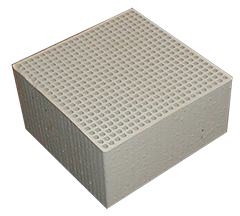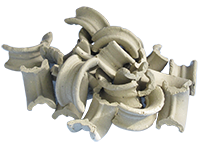Pressure Drop Reduction with Monolith
Monolith media is inherently more efficient than saddles, providing a lower pressure drop while increasing TER. Below is an illustration of a typical application.
Bed Designs:
Monolith:
LA10 43 Cell
Bed Depth: 4′
TER: 96%
Pressure Drop: 5.25 in. w.c.
Saddles:
1″ Saddles
Bed Depth: 8′
TER: 93.7%
Pressure Drop: 14.4 in. w.c.
Results:
Pressure Drop:
Monolith: 5.25 in. w.c.
Saddles: 14.4 in. w.c.
Reduction in ΔP: over 63% pressure drop reduction
TER:
Monolith: 96.0%
Saddles: 93.7%
TER Difference: 2.5% TER increase or approximately a 45% gas savings
Benefits:
A bed composed entirely of 1″ saddles cannot typically achieve 96% TER while maintaining reasonable bed height or pressure drop, and saddle pressure drop will always be higher than monolith due to required bed depths and turbulent air flow. Monolith is a great option for increasing capacity of existing units that previously utilized saddles without the need to resize units or increase fan capacity. However, saddles can be very effective for gas distribution; or as a sacrificial media for short life applications such as extreme plugging due to silica or other inorganics. This is where Lexco’s innovative hybrid bed designs can really shine
Unit Parameters:
Gas Volume (scfm): 18,000
Chamber Size: 80 ft2
Number of Chambers: 2
Tin: 100°F
Tcomb: 1500°F
Cycle time: 180 sec
Dry Air, at sea level



